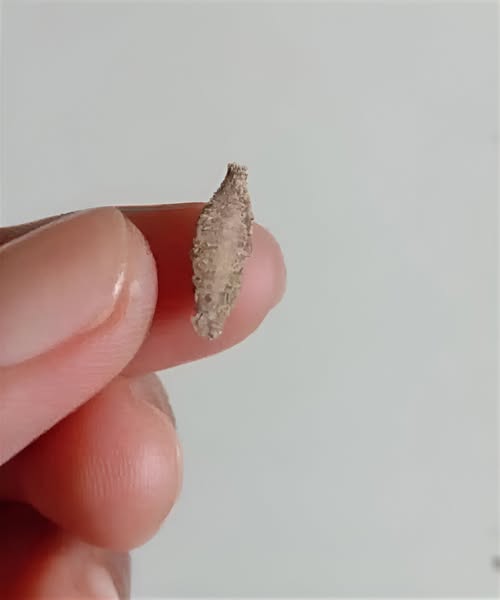Kamitetep belong to the Tineidae family, which includes the same moths notorious for devouring wool sweaters and silk dresses. These insects thrive in warm, humid environments, making tropical and subtropical climates their ideal breeding grounds. In homes, they gravitate toward closets, basements, garages, and storage areas—anywhere dark and undisturbed.
While adults are small, measuring about half an inch long, their larvae are the real menace. During this stage, they build a distinctive gray, flat case out of silk mixed with dust, lint, and fibers collected from their surroundings. This portable case acts as both armor and shelter, protecting the larva from predators and environmental stress while doubling as a pupation chamber once they mature.
The Life Cycle of Destruction
The kamitetep’s life cycle consists of four stages: egg, larva, pupa, and adult moth.
Eggs are usually laid in hidden corners, behind furniture, or near light fixtures where humidity is high.
Larvae, the feeding stage, carry their little “bags” everywhere and are responsible for most of the damage.
Pupae remain inside those same cases as they transform.
Adults emerge as weak fliers with grayish-brown, scale-covered wings. They don’t eat much themselves—but they lay the eggs that restart the cycle.
Under ideal conditions, a single generation can develop in as little as two to three months, meaning infestations can multiply fast if unchecked.
What Do They Eat?
Kamitetep larvae have a surprisingly varied diet. They feast on organic debris—dust, lint, human and pet hair, spiderwebs, and even the remains of dead insects. But what makes them particularly destructive is their taste for protein-rich natural fibers like wool, silk, feathers, and leather.
That means your favorite winter coat, silk scarf, feather pillow, or wool carpet could be their next meal.
Interestingly, they generally avoid cotton and synthetic materials, preferring natural fibers instead. Paper and cardboard are also on their menu, which is why they’ve been known to damage books, documents, and art if given enough time.
Where Do They Hide?
Kamitetep thrive in dark, humid, undisturbed areas, making them difficult to detect until the damage is already done. Common hiding spots include:
Under beds or furniture
Behind baseboards and picture frames
Inside air vents and light fixtures
In cardboard boxes stored for long periods
Inside closets packed with clothes or linens
The telltale sign of an infestation is the presence of tiny, gray, capsule-like cases hanging on walls or lying on the floor. These are not cocoons—they’re mobile homes built by the larvae. If you see more than a few, you already have a problem.
How to Prevent and Control Kamitetep
The best defense against kamitetep is prevention—keeping your home clean, dry, and inhospitable to these insects. Here’s how to do it effectively:
Vacuum regularly and thoroughly.
Focus on corners, baseboards, under furniture, and inside closets. Don’t just vacuum visible dirt—target the hidden spaces where lint and hair accumulate. Dispose of vacuum bags immediately after cleaning to prevent larvae from escaping.
Reduce humidity.
Kamitetep thrive in damp conditions. Use a dehumidifier in basements, bathrooms, or poorly ventilated areas. Open windows or use fans to circulate air.
Seal cracks and gaps.
Use caulk or weather stripping to block entry points around windows, doors, and vents. These insects often enter from the outside or move between rooms through small gaps.
Declutter storage spaces.
Clutter provides ideal hiding spots and endless food sources. Keep clothes neatly stored, and avoid piling fabrics or cardboard boxes.
Protect vulnerable items.
Store wool, silk, and feathered items in airtight containers or vacuum-sealed bags. For seasonal clothing, consider adding cedar blocks or moth repellent sachets.
Clean natural fibers regularly.
Wash or dry-clean wool and silk garments before storing them. The natural oils and sweat residues on unwashed fabrics attract moths and larvae.
Remove spiderwebs and dead insects.
Kamitetep often feed on spiderwebs and carcasses. A buildup of these materials can signal both a spider problem and a buffet for these pests.
What to Do If You Already Have an Infestation
If you’ve spotted kamitetep cases or larvae crawling on walls or ceilings, immediate action is necessary. Start by doing a deep clean of all affected areas. Vacuum, dust, and wipe surfaces with a mild detergent.
Next, use insecticidal sprays designed for moth larvae. Always follow label instructions carefully, especially if you have children or pets. Spray cracks, corners, and dark recesses where larvae might be hiding.
For more severe infestations, it’s wise to call a professional pest control service. Experts can locate hidden breeding areas—such as inside ductwork or insulation—and use targeted treatments to eradicate the problem entirely.
A Hidden Warning
While kamitetep don’t bite or spread disease, their presence shouldn’t be dismissed as harmless. They can cause irreversible damage to valuable items, particularly those made of natural materials. Worse yet, because they sometimes feed on spiderwebs, finding them can also be a sign of a hidden spider infestation—a double problem you’ll want to tackle quickly.
Protecting Your Home for Good
Keeping kamitetep away isn’t a one-time task—it’s about developing consistent habits. Regular cleaning, air circulation, and reducing moisture will make your home far less appealing to them.
If you live in a humid region, consider investing in moisture-absorbing products or installing ventilation fans in closets or storage areas. Inspect your home seasonally—especially during summer, when infestations are most likely to start.
A Tiny Threat, A Big Lesson
Kamitetep might seem like an odd, insignificant insect clinging quietly to your walls. But beneath that harmless exterior lies a persistent, destructive pest that thrives in neglect. They remind us that even the smallest invaders can cause the biggest problems when we stop paying attention.
The good news? With vigilance, cleanliness, and quick response, they can be completely eliminated.
So next time you spot a strange gray “bag” hanging from your wall, don’t ignore it. It’s not decoration—it’s a warning. Remove it, clean up, and protect your home. Because when it comes to kamitetep, prevention isn’t just the best cure—it’s the only one that truly works.

